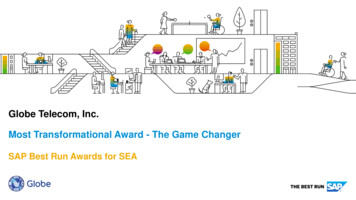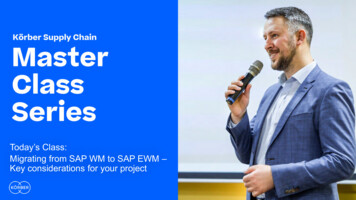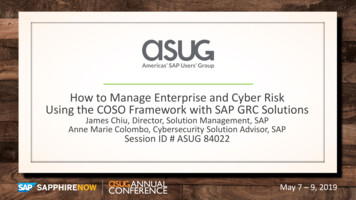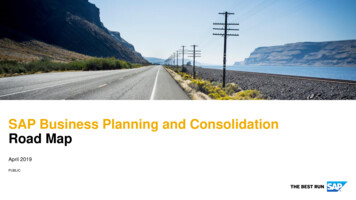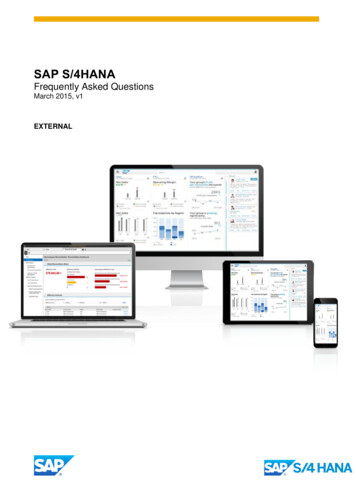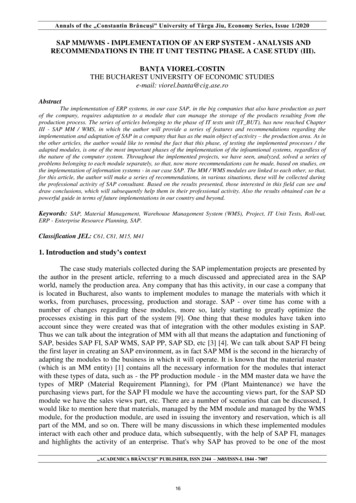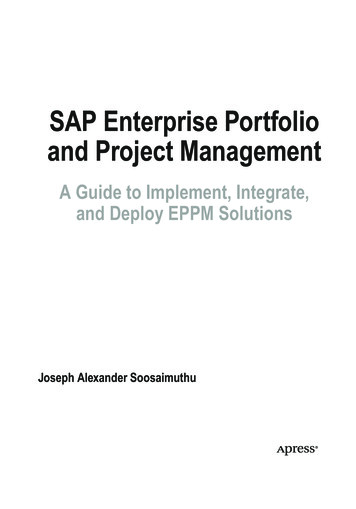
Transcription
SAP Enterprise Portfolioand Project ManagementA Guide to Implement, Integrate,and Deploy EPPM SolutionsJoseph Alexander Soosaimuthu
SAP Enterprise Portfolio and Project Management: A Guide to Implement, Integrate,and Deploy EPPM SolutionsJoseph Alexander SoosaimuthuSydney, NSW, AustraliaISBN-13 (pbk): 2-7863-5ISBN-13 (electronic): 978-1-4842-7863-5Copyright 2022 by Joseph Alexander SoosaimuthuThis work is subject to copyright. All rights are reserved by the Publisher, whether the whole or part of thematerial is concerned, specifically the rights of translation, reprinting, reuse of illustrations, recitation,broadcasting, reproduction on microfilms or in any other physical way, and transmission or informationstorage and retrieval, electronic adaptation, computer software, or by similar or dissimilar methodology nowknown or hereafter developed.Trademarked names, logos, and images may appear in this book. Rather than use a trademark symbol withevery occurrence of a trademarked name, logo, or image we use the names, logos, and images only in aneditorial fashion and to the benefit of the trademark owner, with no intention of infringement of thetrademark.The use in this publication of trade names, trademarks, service marks, and similar terms, even if they are notidentified as such, is not to be taken as an expression of opinion as to whether or not they are subject toproprietary rights.While the advice and information in this book are believed to be true and accurate at the date of publication,neither the authors nor the editors nor the publisher can accept any legal responsibility for any errors oromissions that may be made. The publisher makes no warranty, express or implied, with respect to thematerial contained herein.Managing Director, Apress Media LLC: Welmoed SpahrAcquisitions Editor: Divya ModiDevelopment Editor: James MarkhamCoordinating Editor: Divya ModiCopyeditor: Kezia EndsleyCover designed by eStudioCalamarCover image designed by PixabayDistributed to the book trade worldwide by Springer Science Business Media New York, 1 New York Plaza,New York, NY 10004. Phone 1-800-SPRINGER, fax (201) 348-4505, e-mail orders-ny@springer-sbm.com,or visit www.springeronline.com. Apress Media, LLC is a California LLC and the sole member (owner) isSpringer Science Business Media Finance Inc (SSBM Finance Inc). SSBM Finance Inc is a Delawarecorporation.For information on translations, please e-mail booktranslations@springernature.com; for reprint,paperback, or audio rights, please e-mail bookpermissions@springernature.com.Apress titles may be purchased in bulk for academic, corporate, or promotional use. eBook versions andlicenses are also available for most titles. For more information, reference our Print and eBook Bulk Salesweb page at http://www.apress.com/bulk-sales.Any source code or other supplementary material referenced by the author in this book is available toreaders on GitHub via the book’s product page, located at -Management. For more detailed information, please visit http://www.apress.com/source-code.Printed on acid-free paper
I dedicate this book to my late beloved father, J.SOOSAIMUTHU,who mentored and emboldened me to lead an insightful life.I also dedicate this book to my dear mother, NIRMALA,who bestowed precious virtues by her infallible love.
Table of ContentsAbout the Author xiAcknowledgments xiiiChapter 1: Enterprise Project, Program, and Portfolio ManagementFundamentals 1Enterprise and Organizational Structure 2Project Work Breakdown Structure 3Project Definition 4What Is a Project? 4When Is a Project Created? 5Work Breakdown Structure 7Project Network 7Activities 8Milestones 9Activity Elements 10Subnetworks 11Integration with Other SAP Modules 11Integration with Plant Maintenance 11Integration with Sales and Distribution 12Integration with Material Management 14Integration with Production Planning 19Integration with Controlling 20Periodic Settlement vs. Full Settlement 28Integration with Finance 30General Ledger vs. Cost Element 36Portfolio and Program Structures 37v
Table of ContentsCreating Portfolios 38Integration of Project Management with Portfolio and Program Management 39Synchronizing Project, Program, and Portfolio Structures 40Vertical Synchronization 41Horizontal Synchronization 42Prioritization Framework 44Activities for this Chapter 49Summary 51Chapter 2: SAP Enterprise Portfolio and Project Management Using SAP PS,PPM, and CPM 53Project Planning and Forecasting 54Different Planning and Forecasting Methods 54Guidelines Related to Planning, Actual, and Forecast 63Network Costing 65Project Budgeting 86Overall vs. Annual Budget 87Release vs. Current Budget 88SAP Project Budgeting Fundamentals 90Year End Budget Carry Forward 112Useful Transactions in Budgeting 116Project Variation Management 116Project RAG Status Commentary 121Project Risk, Issue, and Change Request Registers 124Project Procurement and Project Execution 129Prerequisites 130Network Planning and Execution 132Project Resource Planning 133Project Billing 145Progress or Milestone Based Billing 146Resource Related Billing (RRB) 147Periodic Billing 150vi
Table of ContentsProject Delivery-Based Billing 152Order-Based Billing in Assembly Processing 159Project Settlement and Capitalization 164Project Settlement and Capitalization 164Settlement Rule 165Settlement Profile 166Settlement Strategy 166Settlement Types in the Settlement Rule 168Settlement Processing Type 170Settlement Processing 171Settlement Scenarios 172Project Closure 174Activities for this Chapter 178Test Your Learning 180Summary 181Chapter 3: Interface with Scheduling, Estimation, Costing, and ForecastingApplications 183Fundamentals of Scheduling 184Project Calendar 184Scheduling Type and Scenarios 187Network Diagram 189Recording Actual Work 192Project Variations and Their Impact on Scheduling 194Scheduling and Its Impact on Forecasting 195Detailed Date and Schedule Planning 197Integration with Procurement and Production 198Integration with Resource Management 202SAP Interface with Schedule Management Applications 204Why is the interface to third party schedule management application required? 204Design Principles for the Interface 206vii
Table of ContentsFundamentals of Estimation and Costing 218Internal Labor 218External Labor/Service 220Subcontracting (Externally Processed Activities) 222Internal Material 223External Material 224SAP Interface with Estimation and Costing Applications 226Why is the interface to the third party estimation and costing application required? 231Design Principles for the Interface 232SAP Interface with Forecasting Applications or Products 235Why is the interface to the third party forecasting application required? 235Design Principles for the Integration 236Activities for this Chapter 238Test Your Learning 240Summary 241Chapter 4: Industry Best Practices and Business Recommendations 243Industry Best Practices 244Mobility and App Based Project Management Solutions (Cross Industry) 244Resource-Related Billing (Professional Service) 270Revenue Recognition via Results Analysis and Integration with Revenue Accountingand Reporting (IFRS) (Cross Industry) 272Project Management Controls 275Portfolio and Program Management Controls and Decision Making 286Project Accounting and Integration with Other Modules/Third-Party Applications(Cross Industry) 289Phases and Decision Points: (Government or Public Sector; New ProductDevelopment; Infrastructure projects of Telecom and Utilities)) 291Business Challenge: Project Structure 295Work Breakdown Structure vs. Cost Breakdown Structure 296Recommendation on Work Breakdown Structure vs. Cost Breakdown Structure 296Business Challenge: Level of Planning During the Lifecycle of the Project 297Estimates (BoQ/BoS/BoM) 297viii
Table of ContentsDetailed Plan (Schedule of Quantities, Services, and Materials Against a Delivery Plan) 298Recommendation About the Level of Planning 299Business Challenge: Remote Project Location, Offshore Work, or Work Location withNo Computer Access 299Recommendation about Remote Work and Offshore Work 300Business Challenge: When to Use Mass Upload 300Mass Upload: When to Use It and When Not to? 301Recommendations Regarding Mass Upload 302Commonly Asked Questions 304When a Project Involves an Internal Customer and Deliverer, Should the InternalCustomer and its Deliverers Be Housed in One Project? 304Variation Management Using Claims vs. CPM Change Request vs.Version Management (Baselining)—Which Method Is Better? 306Network Costing vs. Easy Cost Planning—Which Is Better? 307How Do You Manage Narratives for a Project? 307Standard RICEFW List by Industry 308Standard Functionality List by Industry 324Activities for this Chapter 342Test Your Learning 343Summary 344Chapter 5: Reporting and Analytics: Operational and Strategic 345Operational Reporting 346Real-Time Operational Reporting 347Period End/Monthly Operational Reporting 349Strategic Reporting 351Diagnostic and Descriptive Analytics 352Long-Term Trend Analysis 355Predictive Analytics 358Activities for this Chapter 361Test Your Learning 363Summary 364Index 365ix
About the AuthorJoseph Alexander Soosaimuthu is a professionally certifiedbusiness process and integration expert with more than 17years of SAP consulting experience, which includes ten endto-end project implementations in APJ, MENA, and EUR.He has extensive solution, design, and delivery experienceand has worked in various capacities, including as afunctional expert, data migration expert, solution architect,and roll-out manager.He holds a bachelor’s degree in civil engineering fromthe National Institute of Technology, Tiruchirappalli (NITT) and is certified in ProjectSystem (SAP PS), Management Accounting (SAP CO), and Business Foundation &Integration (SAP TERP10).xi
AcknowledgmentsFirst, I want to thank the LORD for giving me the knowledge and health to authorthis book.Second, I want to show my deepest appreciation to my loving wife, Anne Nisha,for her unfailing support and to my beloved children, Fiona, Shaun, and Christof Arlo,who cooperated during the busy times of lockdown. I also want to express my sinceregratitude to my extended family and friends, who inspired me in many ways to writethis book.Third, I want to extend special thanks to Harikrishna, Divya, James, and Mark, myproduction and editorial team, for their review and support.Last but not least, this book would not have been possible without my clients andcolleagues, who provided me with rich experiences to write this book.xiii
Trademarked names, logos, and images may appear in this book. Rather than use a trademark symbol with every occurrence of a trademarked name, logo, or image we use the names, logos, and images only in an . Integration with Production Plann




